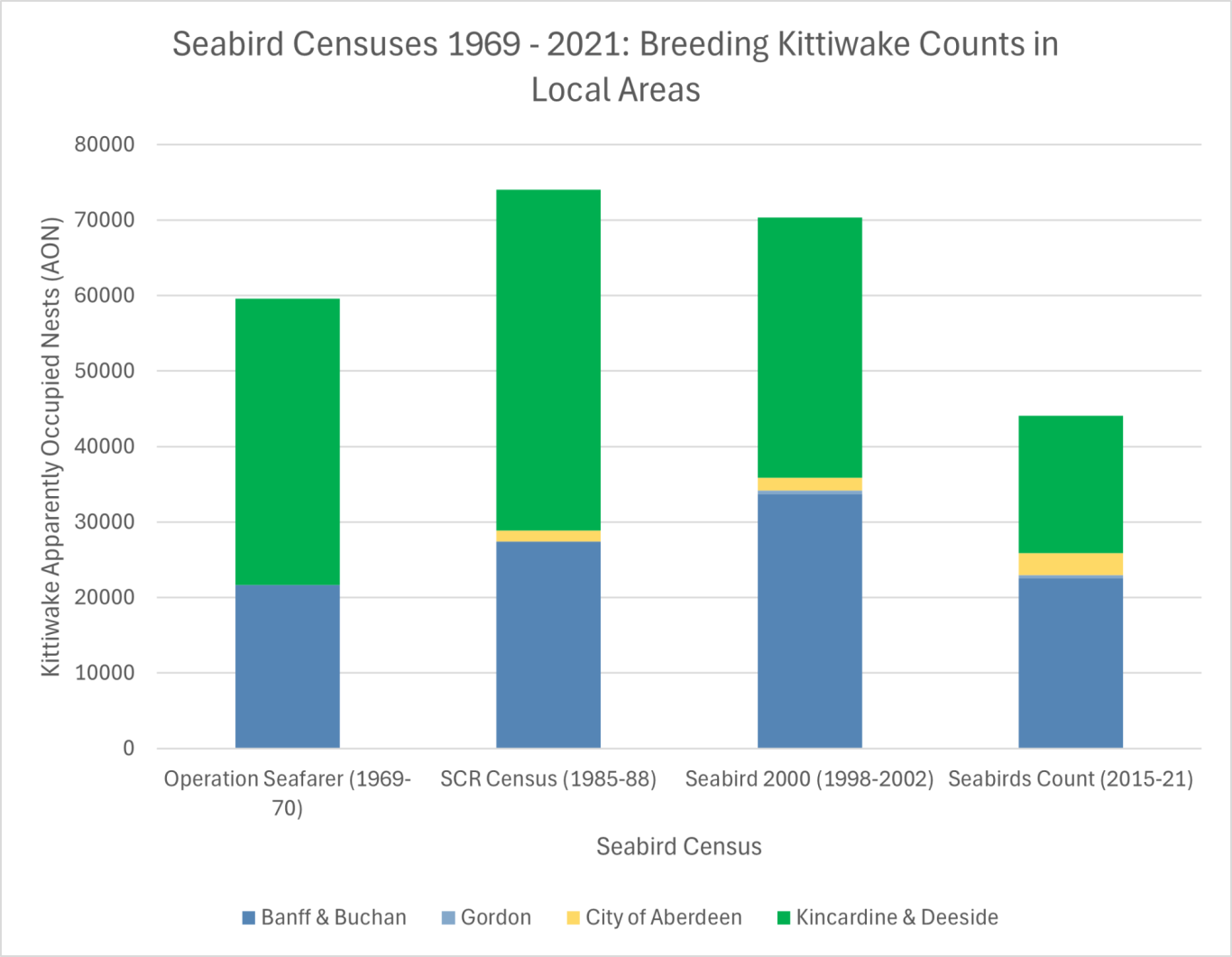Kittiwake - Rissa tridactyla
Key Findings
Kittiwake (Rissa tridactyla) are a small gull, named for their distinctive and repetitive 'kitt-i-waaake' call. Adult breeding plumage consists of a white body, pale grey wings with black wing tips, short black legs, and a slim yellow beak (fig. 1) (Svensson et al, 2020). Kittiwake are sea-cliff nesters, usually in large colonies. Their diet consists of small fish such as sandeels, herring or sprat. Kittiwake typically live to around 12 years old, breeding at 4 years (Harris et al, 2024)
Population & Distribution:
Kittiwake are a common resident species, but most abundant off and around the east coast during the summer and autumn months. Around 6% of the global kittiwake breeding population is hosted by Britain and Ireland, with 50% of this population found in Scotland (fig. 2) (Burnell et al, 2023; Harris et al, 2024). Figure 3 shows how kittiwakes use the seas around Scotland, with the waters in the immediate east coast being a key area of high usage.
Kittiwakes have been recorded at nesting sites all along the east coast (fig. 4) - with key cliff stretches over the years including Peterhead to Collieston (including Bullers of Buchan and Forvie NNR), RSPB Fowlsheugh, and Dunnotar to Catterline (North East Bird Reports).
Conservation Status:
Kittiwake are a Red listed species due to a severe breeding population decline over at least 25 years. They are considered globally threatened (Stanbury et al, 2024).
Factors Impacting Kittiwake:
Kittiwakes are 'surface-feeders', which means they are impacted by changes in food availability. Rising sea temperatures are changing the distribution of sandeels, with warmer waters reducing sandeel recruitment and therefore reducing kittiwake prey availability (Frederiksen et al, 2004). Fishing pressures are also impacting kittiwake populations, with higher breeding success found following local sandeel fishing bans (Searle et al, 2023). The implementation of sandeel fishing bans in Scottish & English waters in April 2024 aims to reduce this fishing pressure on seabird populations, including kittiwake.
Highly Pathogenic Avian Influenza (HPAI) has impacted kittiwakes both locally and nationally. However a 21% increase in Scotland was reported between 2018 pre-HPAI baseline figures and 2023 - it is possible that although there was a moderate level of HPAI fatalities observed, HPAI caused a decline in their usual predators (e.g. great skua Stercorarius skua) in some localities, resulting in a potential net positive effect from HPAI across Scotland (Harris et al, 2024; Tremlett et al, 2024).
Report any sightings to BirdTrack, or NESBReC via the link below.

fig. 1: (Yathin S Krishnappa) - Kittiwake

fig. 2: (Mitchell et al, 2004; Burnell et al, 2023) Kittiwake Counts in Scotland for each Seabird Census 1969 - 2021

fig. 3: (Wakefield et al, 2017) Distributions of Kittiwakes based on 583 tracked birds at 20 sites - from RSPB FAME and STAR projects

fig. 4: (Mitchell et al, 2004; Burnell et al, 2023) Kittiwake Counts in Local Areas for each Seabird Census 1969 - 2021
Notes
None
Linked Information Sheets
Key sources of Information
Reviewed on/by
Status
First draft (one link missing)
To report errors, highlight new data, or discuss alternative interpretations, please complete the form below and we will aim to respond to you within 28 days
Contact us
Telephone: 07971149117
E-mail: ian.hay@stateofthecoast.scot
We need your consent to load the translations
We use a third-party service to translate the website content that may collect data about your activity. Please review the details in the privacy policy and accept the service to view the translations.

